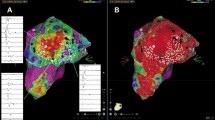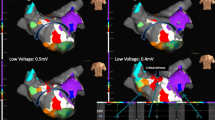Abstract
Purpose
To provide a brief overview of some relevant technological advances in the field of three-dimensional electroanatomical mapping (3D-EAM) that have recently entered the clinical arena and their role in guiding catheter ablation (CA) of complex atrial and ventricular arrhythmias.
Methods
In this technical report, we describe the general features of three novel algorithms featured in the updated CARTO PRIME™ mapping module for CARTO®3 version 7 3D-EAM system (Biosense Webster Inc., Diamond Bar, CA, USA): local activation time (LAT) hybrid, coherent mapping and map replay modules. We also report three challenging arrhythmia cases in which CA was successfully guided by these softwares.
Results
The LAT hybrid module was used in a case of premature ventricular complex originating from the right coronary cusp. This algorithm facilitated safe positioning of the ablation catheter away from the right coronary ostium, avoiding potential harm to this vital structure. The coherent mapping module helped to identify the critical as well as a bystander isthmus of an atrial macro-re-entrant tachycardia in a grown-up patient with congenital heart disease. The map replay module allowed rapid retrospective activation mapping of two unstable ventricular tachycardias in a case of nonischemic cocaine-associated cardiomyopathy.
Conclusion
3D-EAM systems offer significant advantages in the management of challenging arrhythmias, and the introduction of novel algorithms underpins improvements in patients’ outcomes. Given the increasing sophistication of these systems, however, a close collaboration among cardiac electrophysiologists, engineers and technicians is highly needed in order to get the best from the available technology.






Similar content being viewed by others
Data availability
Available data.
References
Cronin EM, Bogun FM, Maury P, Peichl P, Chen M, Namboodiri N, et al. 2019 HRS/EHRA/APHRS/LAHRS expert consensus statement on catheter ablation of ventricular arrhythmias. Europace. 2019;21(8):1143–4.
Yamada T, McElderry HT, Doppalapudi H, Murakami Y, Yoshida Y, Yoshida N, et al. Idiopathic ventricular arrhythmias originating from the aortic root prevalence, electrocardiographic and electrophysiologic characteristics, and results of radiofrequency catheter ablation. J Am Coll Cardiol. 2008;52(2):139–47.
Sassone B, Muser D, Casella M, Luzi M, Virzì S, Balla C, Nucifora G; Task force on imaging and task force on ablation of ventricular tachycardia of the Italian Association of Arrhythmias and Cardiac Pacing (AIAC). Detection of concealed structural heart disease by imaging in patients with apparently idiopathic premature ventricular complexes: a review of current literature. Clin Cardiol 2019 Dec;42(12):1162–1169.
Coffey JO, d'Avila A, Dukkipati S, Danik SB, Gangireddy SR, Koruth JS, et al. Catheter ablation of scar-related atypical atrial flutter. Europace. 2013;15(3):414–9.
De Potter T, Iliodromitis K, Bar-On T, Silva Garcia E, Ector J. Premature ventricular contractions cause a position shift in 3D mapping systems: analysis, quantification, and correction by hybrid activation mapping. Europace. 2020;22:607. https://doi.org/10.1093/europace/euaa013.
Anter E, Duytschaever M, Shen C, Strisciuglio T, Leshem E, Contreras-Valdes FM, et al. Activation mapping with integration of vector and velocity information improves the ability to identify the mechanism and location of complex scar-related atrial tachycardias. Circ Arrhythm Electrophysiol. 2018;11(8):e006536.
Lin D, Ilkhanoff L. Twelve-lead electrocardiographic characteristics of the aortic cusp region guided by intracardiac echocardiography and electroanatomic mapping. Heart Rhythm. 2008;5(5):663–9.
Casella M, Gasperetti A, Gianni C, Zucchelli G, Notarstefano P, Al-Ahmad A, et al. Ablation index as a predictor of long-term efficacy in premature ventricular complex ablation: a regional target value analysis. Heart Rhythm. 2019;16(6):888–95.
Walsh EP, Cecchin F. Arrhythmias in adult patients with congenital heart disease. Circulation. 2007;115:534–45.
Hernández-Madrid A, Paul T, Abrams D, Aziz PF, Blom NA, Chen J, et al. ESC Scientific Document Group. Arrhythmias in congenital heart disease: a position paper of the European Heart Rhythm Association (EHRA), Association for European Paediatric and Congenital Cardiology (AEPC), and the European Society of Cardiology (ESC) Working Group on Grown-up Congenital heart disease, endorsed by HRS, PACES, APHRS, and SOLAECE. Europace. 2018;20(11):1719–53.
Drago F, Russo MS, Marazzi R, Salerno-Uriarte JA, Silvetti MS, De Ponti R. Atrial tachycardias in patients with congenital heart disease: a minimally invasive simplified approach in the use of three-dimensional electroanatomic mapping. Europace. 2011;13(5):689–95.
Klehs S, Schneider HE, Backhoff D, Paul T, Krause U. Radiofrequency catheter ablation of atrial tachycardias in congenital heart disease: results with special reference to complexity of underlying anatomy. Circ Arrhythm Electrophysiol. 2017;10(12):e005451.
Mantziari L, Butcher C, Shi R, Kontogeorgis A, Opel A, Chen Z, et al. Characterization of the mechanism and substrate of atrial tachycardia using ultra-high-density mapping in adults with congenital heart disease: impact on clinical outcomes. J Am Heart Assoc. 2019;8(4):e010535.
Asferg C, Chen X, Pehrson S, Jacobsen PK. Catheter ablation of atypical flutter using new 3-dimensional electroanatomic mapping software focusing on areas of conduction block. HeartRhythm Case Rep. 2019;5(4):225–8.
Nichol G, Sayre M, Guerra F, Poole J. Defibrillation for ventricular fibrillation: a shocking update. J Am Coll Cardiol. 2017;70(12):1496–150.
Guerra F, Palmisano P, Dell'Era G, Ziacchi M, Ammendola E, Bonelli P, et al. Implantable cardioverter-defibrillator programming and electrical storm: results of the OBSERVational registry On long-term outcome of ICD patients (OBSERVO-ICD). Heart Rhythm. 2016;13(10):1987–92.
Santangeli P, Marchlinski FE. Substrate mapping for unstable ventricular tachycardia. Heart Rhythm. 2016;13(2):569–83.
Kautzner J, Peichl P. Mapping and ablation of unmappable ventricular tachycardia, ventricular tachycardia storm, and those in acute myocardial infarction. Card Electrophysiol Clin. 2019;11(4):675–88.
Havakuk O, Rezkalla SH, Kloner RA. The cardiovascular effects of cocaine. J Am Coll Cardiol. 2017;70(1):101–13.
Priori SG, Blomström-Lundqvist C, Mazzanti A, Blom N, Borggrefe M, Camm J, et al. ESC guidelines for the management of patients with ventricular arrhythmias and the prevention of sudden cardiac death: the task force for the management of patients with ventricular arrhythmias and the prevention of sudden cardiac death of the European Society of Cardiology (ESC). Endorsed by: Association for European Paediatric and Congenital Cardiology (AEPC). Eur Heart J. 2015;36(41):2793–867.
Acknowledgements
The authors acknowledge Matteo Mirarchi, BE, for technical support in image editing.
Author information
Authors and Affiliations
Corresponding author
Ethics declarations
Conflict of interest
The authors declare that they have no conflict of interest.
Ethical approval
Yes.
Consent to participate
Yes.
Consent for publication
Yes.
Additional information
Publisher’s note
Springer Nature remains neutral with regard to jurisdictional claims in published maps and institutional affiliations.
Electronic supplementary material
ESM 1
Propagation map of atrial macro-re-entrant tachycardia obtained with the coherent mapping module. Note the critical isthmus in the region between the inferior cava vein and the scar due to prior atriotomy and, also, a second bystander isthmus in the superior portion of the posterior wall, close to the superior cava vein. The representation of small moving vectors simplifies interpretation of arrhythmia’s circuitry. (MP4 44,322 kb)
Rights and permissions
About this article
Cite this article
Compagnucci, P., Volpato, G., Falanga, U. et al. Recent advances in three-dimensional electroanatomical mapping guidance for the ablation of complex atrial and ventricular arrhythmias. J Interv Card Electrophysiol 61, 37–43 (2021). https://doi.org/10.1007/s10840-020-00781-3
Received:
Accepted:
Published:
Issue Date:
DOI: https://doi.org/10.1007/s10840-020-00781-3




